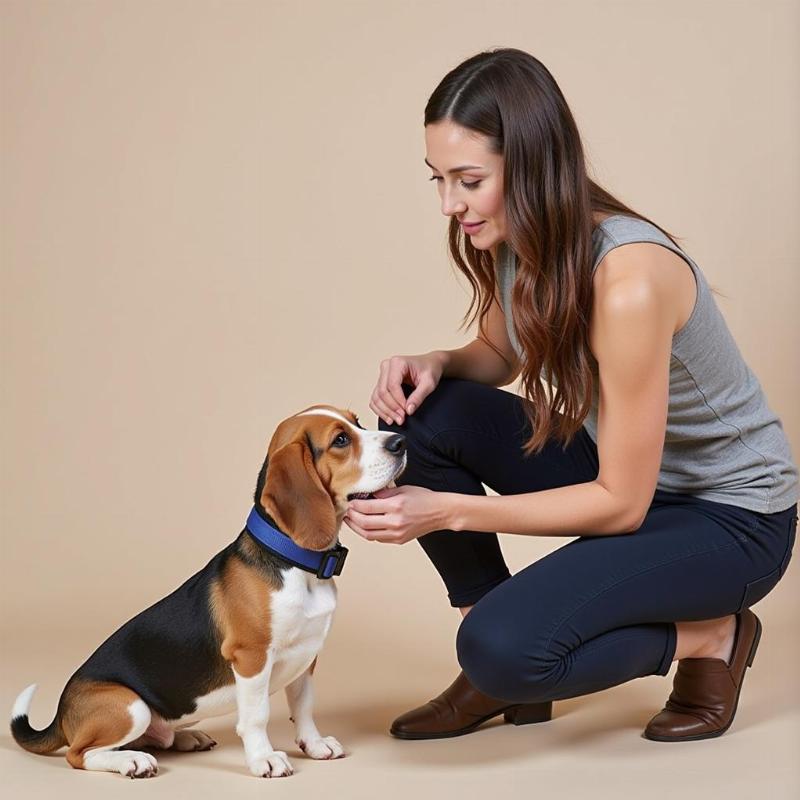Choosing the right bark control method for your small dog can be a challenge. A “small dog no bark collar” offers a potential solution, focusing on humane training techniques to curb excessive barking. This article dives into the world of no-bark collars designed specifically for small breeds, exploring the different types available, their effectiveness, and how to choose the best option for your furry friend. We’ll also discuss training tips and alternative methods to help you achieve a peaceful and harmonious home.
Understanding the Need for Bark Control in Small Dogs
While a few barks here and there are normal, excessive barking can be disruptive for both you and your neighbors. Small dogs, despite their size, can be surprisingly vocal. Understanding the reasons behind your dog’s barking is the first step towards finding a solution. Are they barking out of boredom, anxiety, territoriality, or perhaps a medical issue? Identifying the trigger can help you address the root cause of the problem.
Exploring No Bark Collar Options for Small Breeds
No bark collars for small dogs utilize various methods to deter barking without causing pain. These include:
- Citronella Collars: These collars release a burst of citronella spray near the dog’s nose when they bark. The scent is unpleasant to dogs, interrupting their barking behavior.
- Ultrasonic Collars: These collars emit a high-pitched sound that only dogs can hear. The sound is designed to startle the dog and interrupt their barking.
- Vibration Collars: These collars deliver a gentle vibration when the dog barks. The sensation is surprising and can deter further barking.
It’s crucial to choose a collar that’s appropriately sized and weighted for your small dog. A collar that’s too heavy or bulky can be uncomfortable and ineffective.
Choosing the Right No Bark Collar: Factors to Consider
Choosing the correct no bark collar is vital for your small dog’s comfort and wellbeing. Consider the following:
- Size and Weight: Opt for a lightweight, adjustable collar designed specifically for small breeds.
- Sensitivity Levels: Look for collars with adjustable sensitivity settings to fine-tune the correction level based on your dog’s barking habits.
- Safety Features: Automatic shut-off features can prevent over-correction and ensure your dog’s safety.
- bark collar for small dogs – no shock
Training Tips for Effective Bark Control
 Training a small dog with a no-bark collar.
Training a small dog with a no-bark collar.
Simply putting a collar on your dog isn’t enough. Combine it with positive reinforcement training techniques for the best results:
- Introduce the Collar Gradually: Let your dog get used to wearing the collar before activating it.
- Reward Good Behavior: When your dog remains quiet, reward them with treats and praise.
- Consistency is Key: Use the collar consistently to reinforce the desired behavior.
- no shock bark collar for small dogs
“Patience and positive reinforcement are crucial when training a small dog with a no-bark collar,” says Dr. Emily Carter, DVM, a veterinary behaviorist in Austin, Texas. “The goal is to teach the dog to associate quiet behavior with positive outcomes.”
Alternatives to No Bark Collars
While no bark collars can be effective, other methods might be more suitable for your dog:
- Behavioral Training: Professional dog trainers can help address underlying behavioral issues causing excessive barking.
- Environmental Enrichment: Providing plenty of toys and activities can prevent boredom-related barking.
- best no bark collar for small dogs
“Sometimes, simple changes in the environment can significantly reduce a dog’s barking,” adds Dr. Carter. “Providing more mental and physical stimulation can work wonders.”
Conclusion
A “small dog no bark collar” can be a valuable tool in managing excessive barking, provided it’s used humanely and responsibly. Remember to choose a collar that’s appropriate for your dog’s size and breed, and combine its use with positive reinforcement training. Explore the different options available, consider your dog’s individual needs, and consult with your veterinarian if necessary. With the right approach, you can help your small dog become a quieter, happier companion.
FAQ
- Are no bark collars safe for small dogs? Yes, as long as you choose a collar specifically designed for small breeds and use it according to the manufacturer’s instructions.
- What type of no bark collar is best for a sensitive small dog? A vibration collar is often the gentlest option.
- How long does it take for a no bark collar to work? Results vary, but with consistent use and training, you should see improvement within a few weeks.
- Can I use a no bark collar on a puppy? Consult your veterinarian before using a no bark collar on a puppy.
- What should I do if my dog continues to bark excessively despite using a no bark collar? Consult with a professional dog trainer or veterinarian to address potential underlying behavioral issues.
- Are there any side effects of using a no bark collar? Some dogs may experience temporary skin irritation or discomfort.
- Can a no bark collar be used in conjunction with other training methods? Yes, combining a no bark collar with positive reinforcement training is often the most effective approach.
Related Articles
Beautdogs.us is your one-stop resource for all things dog-related in the US. We offer expert advice on dog breeds, care, and products, catering to both new and experienced dog owners. From finding the perfect Beautdogs.us product to understanding your dog’s unique needs, we’re here to help you navigate the wonderful world of dog ownership. Contact us for personalized support: Email: [email protected], Phone: +1 501-555-7529.